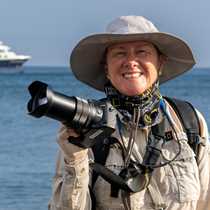Floreana Island
It was an early departure from the ship…before breakfast, and just barely after the sun had risen in the east. A wet landing was made on a dark-sand beach. When the light strikes at the right angle, the sand comes off looking green, a consequence of having olivine crystals. The beach has been formed by the erosion of the nearby tuff cone, and deposited in the lee shore. We crossed over the low saddle of the isthmus and found that the windward side had accumulated the white, calcium carbonate material from parrotfish and other marine consumers of corals. Not only do sea turtles choose this as a favorite beach for nesting (earlier in the year when the climate is hot for incubation), but stingrays also find the fine sand a pleasant place to nestle in the surf – which is why we don’t swim there.
For swimming, instead we sailed over breakfast to Champion Island where all of us enjoyed the ocean on this partly cloudy, partly sunny day: this time by snorkel and mask. The fish were seen in clouds as we dropped into the blue. Large schools of grunts, salemas, surgeonfish and angelfish. The sea lions charged us underwater, bubbles and teeth in our faces as they grinned and made many snorkelers squeal with excitement with the abruptness of their appearance and speed. Others toured on the surface by glass bottom boat, and later by Zodiac – to look for the Floreana mockingbird. This sighting would be our third species of mockingbird in three days – one for each island in the southeast of Galápagos. The fourth – which we will see tomorrow, is the more general mockingbird known as the “Galápagos” mockingbird.
By afternoon, we changed anchorage yet again and settled in Post Office Bay, a bay of so much past history. From wild and crazy Patrick Watkins, to a toothless dentist, to Norwegians trying to survive by fishing, the island today has around 100 inhabitants. We did not see any of them, as they live on the other side of the island or inland where the green highlands allow a sustainable life for a few hardy souls. What we did see, however, was a barrel left behind, one of a series, here since the 1790s. The barrels were originally placed for travelling seamen to leave and receive correspondence during their years away from home…and the tradition continues. Postcards are now the most popular form of correspondence, and some of our guests found a few addressed to folks near their home towns. By taking them from the barrel, they have taken on the responsibility of delivering them to their destination.
The bay is also near a small colony of Galápagos sea lions. Sea turtles popped their heads out of the still inland waters, resting from strong currents and cold temperatures. Along the coast our kayakers paddled in tranquility through shallow water. Others spent their afternoon on the beach of Post Office Bay for some more swimming in the waves, before taking a Zodiac tour around the offshore islets where sea lions and the giant prickly pear cacti of Floreana can be seen. A Floreana marine iguana with its dark-red flanks grazed the rocks, while a great blue heron tended its young in the nest.
By sunset we were once more back on board, this time preparing to head north, towards our next destination. Sweet dreams.




